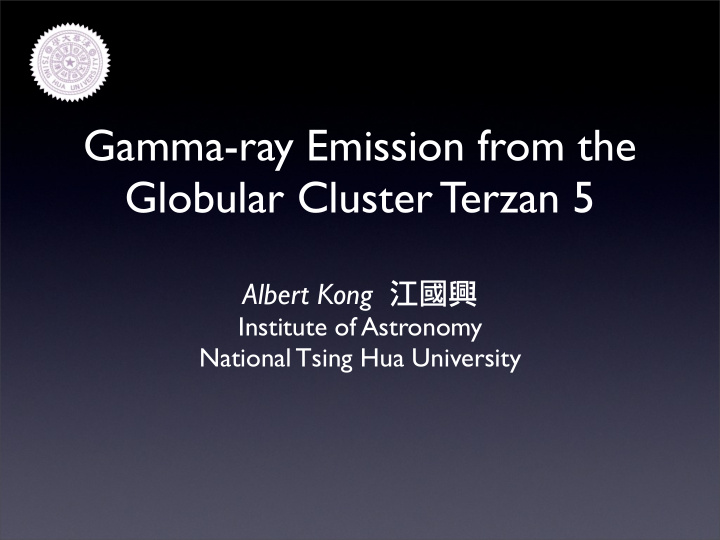



Gamma-ray Emission from the Globular Cluster Terzan 5 Albert Kong 江國興 Institute of Astronomy National Tsing Hua University
Why Globular Clusters? Terzan 5 • The oldest known stars (9-12 Gyr) • All stars in GCs have the same age, distance, and similar chemical composition. • Testbeds for the theory of stellar evolution. • Many interesting close dynamic interactions (e.g. exchanges in encounters with binaries, direct collisions, destruction of binaries, and tidal capture) between stars occur in GCs because of the high stellar density (100-10000 stars/pc 3 ).
High-Energy Sources in GCs • The first X-ray detections were made in 1970s with the Uhuru and OSO-7 Observatories (e.g. Giacconi et al. 1972). • About 10% of luminous (> 10 35 erg/s) X-ray sources in our Galaxy are found in GCs. • The probability of finding a luminous X-ray source in a GC is orders of magnitude higher than in the rest of our Galaxy. • GCs are very efficient factories to produce exotic binary objects like low-mass X-ray binaries, cataclysmic variables (CVs), and millisecond pulsars (MSPs). => Talks: Regina Huang and David Hui
Formation of Close Binaries in GCs • Tidal capture from close encounters due to the high stellar densities (Clark 1975; Fabian et al. 1975) • Verbunt & Hut (1987) showed that the 11 luminous LMXBs known at that time in GCs were consistent with being formed dynamically through close encounters. • Can we quantify the results?
Chandra ROSAT
47 Tuc Chandra 0.5-1.2 keV 1.2-2 keV 2-6 keV
Dynamical Formation of High-Energy Sources in GCs Tex Tex Encounter Frequency Updated after Lu et al. 2009 and Lan et al. 2010
Lan et al. 2010
Stellar Encounters MSP+WD X-ray binary Accreting MSP Supernova NS Y.-J. Yang’s talk
Text From Scott Ransom
Gamma-ray Emission from GCs • Gamma-ray emission is likely to be from MSPs • Pulsed curvature radiation arising near the polar cap and /or in outer magnetospheric gaps (e.g., Zhang & Cheng 2003; Harding et al. 2005; Venter & De Jager 2008) • Inverse Compton scattering photons between the relativistic electrons/positrons in the pulsar winds and the background soft photons (e.g., Bednarek & Sitarek 2007) • See talks by Takata, Cheng, and Y. Wang
Gamma-ray Emission from GCs • Most of the gamma-ray MSPs are very nearby (< 1 kpc) => they are very faint. • The nearest GCs are several kpc from us. It is almost impossible to detect individual MSPs in GCs. • However, GCs can have tens to hundreds of MSPs because of the enhanced dynamical formation (David’s talk). We can detect the collective gamma-ray emission with sensitive instruments. • Terzan 5 and 47 Tuc are the best candidates since they have the largest number of MSPs in GCs. • EGRET only obtained an upper limit • Fermi/LAT can do much better
Theoretical Predictions of MSPs in GCs Venter et al. 2009
First Gamma-ray detection from a GC (47 Tuc) Abdo et al. 2009
Text From Scott Ransom
Fermi 17-month Observations of Terzan 5 27 σ 3.7 σ Kong et al. 2010 You will try a 22-month data set on Wed.
Fermi/LAT Spectrum of Terzan 5 • Exponential cutoff power-law model • Γ = 1.9+/-0.2 • E c = 3.8+/-1.2 GeV • 47 Tuc • Γ = 1.3+/-0.3 • E c = 2.5 (+1.6, -0.8) GeV
Comparison between Terzan 5 and 47 Tuc • Magnetospheric origin: • Encounter frequency of Terzan 5 is higher than that of 47 Tuc => more MSPs • Metallicity is also higher => more MSPs (David Hui’s talk) • Assume that they have the same spin-down power, the ratio of the number of MSPs is N Ter /N Tuc ~ L Ter /L Tuc ~25. The actual observed number is 33/23. • Their spectra are not the same => different physical properties => different spin-down power? • Distance of Terzan 5 (5.5-10.3 kpc) => likely to be the lower end of the estimate
Comparison between Terzan 5 and 47 Tuc • Inverse Compton Scattering: • The background soft photon intensity from the Galactic plane at the position of Terzan 5 is roughly 10 times that of 47 Tuc (Strong & Moskalenko 1998) • Terzan 5 should have stronger emission with energies > 10 GeV (Cheng’s talk) • Future Fermi, MAGIC, and H.E.S.S. observations may tell (Tam’s talk)
Questions and Future Works • Is the gamma-ray spectrum of Terzan 5 unique comparing with other GCs? • What is the emission mechanisms? • > 10 GeV emission? What about H.E.S.S.? • 10-20 GeV image indicates that the source is slightly offset. Is it true? We may tell on Wed. Why is that?
Recommend
More recommend